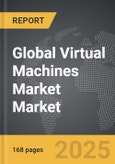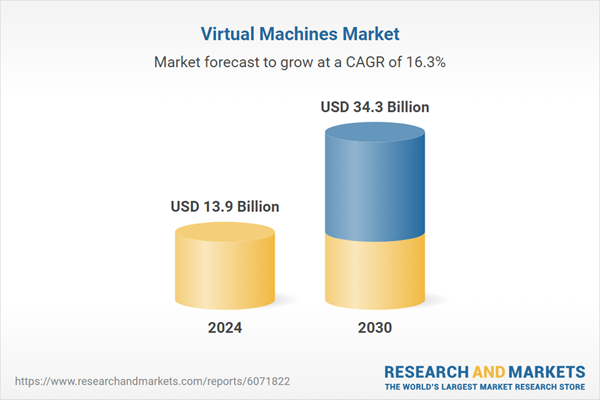Global Virtual Machine Market - Key Trends & Drivers Summarized
Why Are Virtual Machines Becoming an Integral Part of IT Infrastructure?
The adoption of virtual machines (VMs) has become a cornerstone of modern IT infrastructure, enabling organizations to optimize computing resources, enhance flexibility, and reduce operational costs. Virtual machines allow businesses to run multiple operating systems and applications on a single physical server, improving resource utilization and scalability. The increasing shift toward cloud computing, virtualization, and hybrid IT environments has further accelerated the demand for VMs, as companies seek to streamline workloads and improve data center efficiency. Enterprises are leveraging VMs to deploy and manage applications across cloud platforms, reducing the need for dedicated hardware and enabling seamless workload migration. Additionally, virtual machines play a crucial role in cybersecurity, as organizations use them for secure sandboxing, malware testing, and isolated development environments. With the continued expansion of remote work, software development, and cloud-based enterprise solutions, VMs have become an essential tool for enhancing IT agility and operational efficiency.How Are Advancements in Virtualization Technology Improving Virtual Machines?
The evolution of virtualization technology has significantly improved the performance, security, and scalability of virtual machines, making them more efficient and adaptable for enterprise applications. Hypervisor advancements have enabled VMs to achieve near-native performance, allowing for high-speed data processing and seamless resource allocation. The integration of AI-driven automation in VM management has enhanced workload optimization, predictive analytics, and intelligent resource allocation, reducing manual intervention and operational complexity. Additionally, containerization technologies such as Docker and Kubernetes are complementing VMs by enabling lightweight, portable application deployment, further enhancing IT agility. Cloud service providers are also introducing serverless computing models that integrate VMs with microservices architectures, allowing businesses to scale applications dynamically based on demand. Furthermore, improvements in network function virtualization (NFV) and software-defined infrastructure (SDI) are enabling VMs to support next-generation networking applications, including 5G and edge computing. These advancements are making VMs more efficient, cost-effective, and essential for enterprises transitioning to cloud-based and hybrid IT environments.What Challenges Are Limiting the Growth of Virtual Machines?
Despite their advantages, virtual machines face several challenges that impact their adoption and operational efficiency. One of the primary concerns is performance overhead, as running multiple VMs on a single physical server can lead to resource bottlenecks, affecting processing speed and application responsiveness. The complexity of VM management and configuration also poses a challenge, requiring IT teams to invest in specialized skills and tools for efficient deployment and maintenance. Security vulnerabilities associated with multi-tenant environments and shared resources are another concern, as VMs remain susceptible to cyber threats such as hypervisor attacks, unauthorized access, and VM escape exploits. Additionally, the growing preference for containerization and serverless computing has introduced competition for VMs, as some businesses opt for lightweight alternatives that offer faster deployment and lower resource consumption. Cost management is also a challenge, as organizations must balance licensing fees, cloud service expenses, and infrastructure costs when scaling VM-based environments. Addressing these challenges will require ongoing advancements in hypervisor technology, improved security frameworks, and better integration between VMs, containers, and cloud-native architectures.What Factors Are Driving the Growth of the Virtual Machine Market?
The growth in the virtual machine market is driven by several factors, including the increasing adoption of cloud computing, the rise of virtualization in enterprise IT, and the growing demand for scalable computing solutions. The expansion of hybrid cloud environments has fueled the need for VMs that can seamlessly integrate with on-premise and cloud-based infrastructures, enabling flexible workload management. The rapid growth of data-driven applications and AI-powered workloads has also contributed to market expansion, as VMs provide scalable computing resources to support high-performance data processing. Additionally, the shift toward remote work and virtualized desktop infrastructure (VDI) has driven demand for VM-based solutions that enable secure access to enterprise applications from any device. The increasing emphasis on cybersecurity and risk mitigation has further accelerated VM adoption, as businesses deploy isolated virtual environments for testing and malware analysis. With continued advancements in virtualization, automation, and cloud-native computing, the virtual machine market is expected to witness sustained growth, reinforcing its critical role in the future of IT infrastructure and enterprise computing.Report Scope
The report analyzes the Virtual Machines market, presented in terms of market value (US$). The analysis covers the key segments and geographic regions outlined below:- Segments: Type (System Virtual Machine, Process Virtual Machine); Organization Size (Large Enterprises, SMEs); Vertical (BFSI, IT & Telecommunications, Government & Public Sector, Healthcare & Life Sciences, Others).
- Geographic Regions/Countries: World; United States; Canada; Japan; China; Europe (France; Germany; Italy; United Kingdom; and Rest of Europe); Asia-Pacific; Rest of World.
Some of the 36 companies featured in this Virtual Machines market report include -
- Amazon Web Services (AWS)
- Citrix Systems, Inc.
- Dell Technologies Inc.
- Google Cloud Platform (GCP)
- Hewlett Packard Enterprise (HPE)
- Huawei Technologies Co., Ltd.
- IBM Corporation
- KVM (Kernel-based Virtual Machine)
- Microsoft Corporation
- Nutanix, Inc.
- OpenVZ Project
- Oracle Corporation
- Parallels International GmbH
- QEMU
- Red Hat, Inc.
- Sangfor Technologies Inc.
- SolarWinds Worldwide, LLC
- VirtualBox (Oracle Corporation)
- VMware, Inc.
- ZStack
Key Insights:
- Market Growth: Understand the significant growth trajectory of the System Virtual Machine segment, which is expected to reach US$24.7 Billion by 2030 with a CAGR of a 17.6%. The Process Virtual Machine segment is also set to grow at 13.4% CAGR over the analysis period.
- Regional Analysis: Gain insights into the U.S. market, valued at $3.6 Billion in 2024, and China, forecasted to grow at an impressive 15.3% CAGR to reach $5.3 Billion by 2030. Discover growth trends in other key regions, including Japan, Canada, Germany, and the Asia-Pacific.
Why You Should Buy This Report:
- Detailed Market Analysis: Access a thorough analysis of the Global Virtual Machines Market, covering all major geographic regions and market segments.
- Competitive Insights: Get an overview of the competitive landscape, including the market presence of major players across different geographies.
- Future Trends and Drivers: Understand the key trends and drivers shaping the future of the Global Virtual Machines Market.
- Actionable Insights: Benefit from actionable insights that can help you identify new revenue opportunities and make strategic business decisions.
Key Questions Answered:
- How is the Global Virtual Machines Market expected to evolve by 2030?
- What are the main drivers and restraints affecting the market?
- Which market segments will grow the most over the forecast period?
- How will market shares for different regions and segments change by 2030?
- Who are the leading players in the market, and what are their prospects?
Report Features:
- Comprehensive Market Data: Independent analysis of annual sales and market forecasts in US$ Million from 2024 to 2030.
- In-Depth Regional Analysis: Detailed insights into key markets, including the U.S., China, Japan, Canada, Europe, Asia-Pacific, Latin America, Middle East, and Africa.
- Company Profiles: Coverage of players such as AI Influencer Company, AI Models, AvatarOS, Aww Inc., Brud and more.
- Complimentary Updates: Receive free report updates for one year to keep you informed of the latest market developments.
Select Competitors (Total 36 Featured):
- Amazon Web Services (AWS)
- Citrix Systems, Inc.
- Dell Technologies Inc.
- Google Cloud Platform (GCP)
- Hewlett Packard Enterprise (HPE)
- Huawei Technologies Co., Ltd.
- IBM Corporation
- KVM (Kernel-based Virtual Machine)
- Microsoft Corporation
- Nutanix, Inc.
- OpenVZ Project
- Oracle Corporation
- Parallels International GmbH
- QEMU
- Red Hat, Inc.
- Sangfor Technologies Inc.
- SolarWinds Worldwide, LLC
- VirtualBox (Oracle Corporation)
- VMware, Inc.
- ZStack
This edition integrates the latest global trade and economic shifts into comprehensive market analysis. Key updates include:
- Tariff and Trade Impact: Insights into global tariff negotiations across 180+ countries, with analysis of supply chain turbulence, sourcing disruptions, and geographic realignment. Special focus on 2025 as a pivotal year for trade tensions, including updated perspectives on the Trump-era tariffs.
- Adjusted Forecasts and Analytics: Revised global and regional market forecasts through 2030, incorporating tariff effects, economic uncertainty, and structural changes in globalization. Includes historical analysis from 2015 to 2023.
- Strategic Market Dynamics: Evaluation of revised market prospects, regional outlooks, and key economic indicators such as population and urbanization trends.
- Innovation & Technology Trends: Latest developments in product and process innovation, emerging technologies, and key industry drivers shaping the competitive landscape.
- Competitive Intelligence: Updated global market share estimates for 2025, competitive positioning of major players (Strong/Active/Niche/Trivial), and refined focus on leading global brands and core players.
- Expert Insight & Commentary: Strategic analysis from economists, trade experts, and domain specialists to contextualize market shifts and identify emerging opportunities.
Table of Contents
Companies Mentioned (Partial List)
A selection of companies mentioned in this report includes, but is not limited to:
- Amazon Web Services (AWS)
- Citrix Systems, Inc.
- Dell Technologies Inc.
- Google Cloud Platform (GCP)
- Hewlett Packard Enterprise (HPE)
- Huawei Technologies Co., Ltd.
- IBM Corporation
- KVM (Kernel-based Virtual Machine)
- Microsoft Corporation
- Nutanix, Inc.
- OpenVZ Project
- Oracle Corporation
- Parallels International GmbH
- QEMU
- Red Hat, Inc.
- Sangfor Technologies Inc.
- SolarWinds Worldwide, LLC
- VirtualBox (Oracle Corporation)
- VMware, Inc.
- ZStack
Table Information
| Report Attribute | Details |
|---|---|
| No. of Pages | 168 |
| Published | December 2025 |
| Forecast Period | 2024 - 2030 |
| Estimated Market Value ( USD | $ 13.9 Billion |
| Forecasted Market Value ( USD | $ 34.3 Billion |
| Compound Annual Growth Rate | 16.3% |
| Regions Covered | Global |









